United Kingdom
State of Mobile Experience
October 2021
State of Mobile Experience
October 2021
In our annual benchmark report for the United Kingdom, we have evaluated over 3 million speed and latency tests, conducted on the smartphones of real-world users of national mobile operators within Common Coverage Areas, between March and August 2021.
The telecoms industry within the United Kingdom, and its continued investments in technologies to better improve the overall mobile experience, has never been more important to its users than right now. The pandemic highlighted a need for reliable connectivity, and this demand continues to grow. Ericsson’s UK and Ireland CEO recently put it bluntly: “What we used to consider a bit of a luxury has now become a necessity” and UK mobile operators, even in these unprecedented times, are delivering.
In an auction that only took three days to complete, all four major operators in the UK successfully purchased a slice of the 200 MHz made up for grabs across the 700 MHz and 3.6-3.8 GHz bands in March 2021. From October this year, more mobile users on the EE network will be able to test out 5G as the operator started deployment of the 700 MHz band in September, with towns such as Redditch, Morecambe and Cramlington being the first to have it switched on for them.
Three UK reported in August that its outdoor 5G coverage reached 29% of the UK with more than 300 locations able to tap in, while Vodafone UK are taking a slow but more energy-efficient approach to installing 5G across the country, with 1500 of its new light radios provided by Ericsson being deployed from now until April 2022 helping to reduce Vodafone’s overall forecasted energy consumption. While it may seem that the UK is taking a longer time than other countries to fully roll out 5G, operators are realistic and honest about their coverage numbers, with EE’s owner BT expecting to only reach half of the population by 2023, a far cry from the lighting speed adoption of 4G in 2014.
In other non 5G-related news, O2 and Virgin Media finally merged this year, with their first point of business being an upgrade to its broadband offerings. The new company reported in early September that two thirds of homes and businesses already connected to the broadband network will now receive gigabit speeds up to at least 1.13 Gbps. While post-merger news is still focused on what the company is going to do for broadband users, CEO of Virgin Media O2, Lutz Schuler, has outlined a four pronged strategy that includes customers being provided with more on a broadband-mobile convergence plan than they did, separately, before.
Report statisticsDate range: 1 March 2021 - 31 August 2021 Operators
EE |
Report statistics
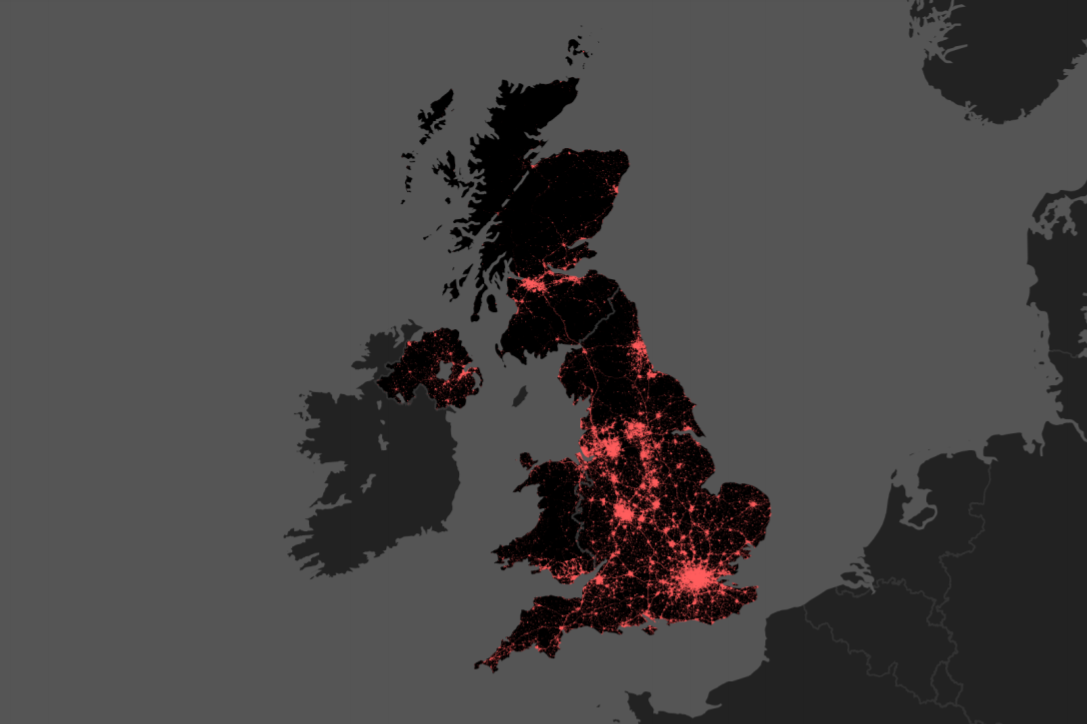
The contents of this report and the awards shown above are copyright Tutela; organisations may republish the awards and results above for editorial purposes; non-commercial uses and on unsponsored social media posts. For all other uses, please contact awards@tutela.com.
This report encompasses the following experience KPIs:
To ensure a fair comparison between operator performance, Tutela limits the results used in our comparisons to those collected within Common Coverage Areas.
Learn more about our benchmarking methodology here.
In Common Coverage Areas across the United Kingdom, EE had the highest Excellent Consistent Quality with 73.0% of connections good enough for demanding applications like 1080p video streaming, HD group video calling and real time mobile gaming. With a difference in performance of 5.3%, 3 was in second place at 67.8%, while O2 was in third place at 66.2% and Vodafone in fourth place at 65.0%.
While no operator reached the 90% threshold for Core Consistent Quality, Tutela’s metric for when a mobile connection meets the requirements for use-cases like SD video streaming, social media sharing and web browsing, EE had the highest Core Consistent Quality at 89.5%, followed by O2 at 85.8%, 3 at 85.3% and Vodafone at 83.9%.
While focussing solely on 5G in Common Coverage Areas across the United Kingdom, 3 had the highest Excellent Consistent Quality at 85.9%. O2 was in second place at 80.6%, followed by a statistical tie between Vodafone and EE for third. Despite its first place rankings for overall highest Consistent Quality, EE fell down the rankings when looking solely at 5G for an Excellent Consistent Quality just over 74%.
3 and O2 were the only operators to reach the 90% threshold, with 3 users experiencing the highest Core Consistent Quality on a 5G network at 92.9%, followed closely by O2 at 90.5%. Vodafone and EE again statistically tied for third place.
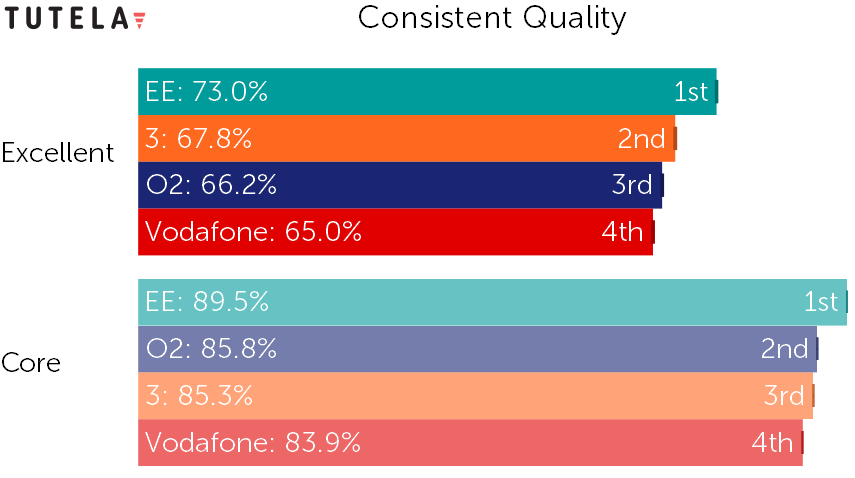
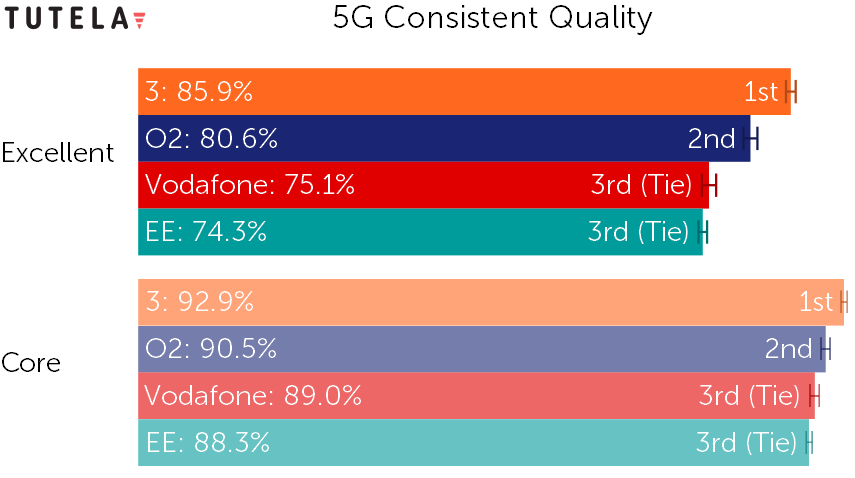
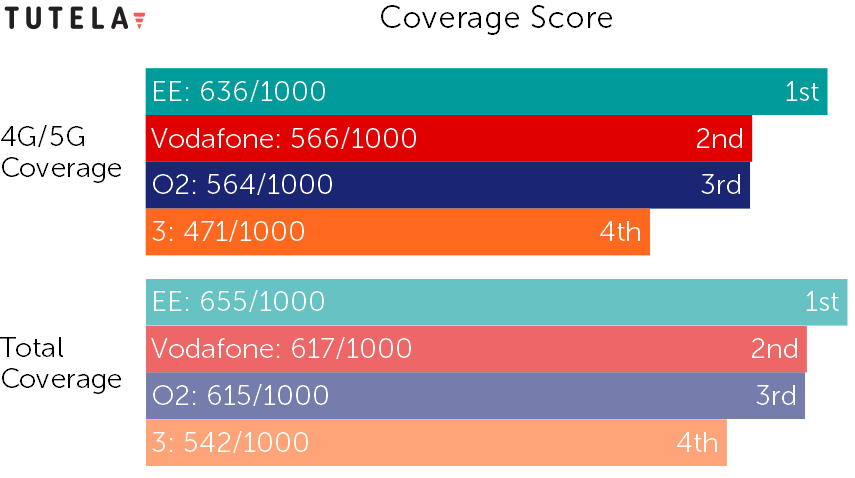

EE demonstrated the greatest relative coverage in the UK, with a 4G/5G coverage score of 636 and a total coverage score of 655. With a points difference of only 19 between the two scores and EE making it their mission to switch off 3G by 2023 mobile users on this network are tapping into 4G/5G a majority of the time. A new chart has been added to this report that showcases 5G on its own, and it's unsurprising that the coverage scores are low in comparison to 4G coverage but we know this will improve as more consumers tap into 5G. Keeping that in mind, EE had the greatest 5G coverage score in the UK at 70 points out of 100.
In second place, and with a points difference of 70 behind EE, Vodafone was in second place with a 4G/5G coverage score of 566 and total coverage score of 617. For 5G, Vodafone was in fourth place with a coverage score 32 out of 100, 38 points behind first place EE.
O2 placed third with a 4G/5G coverage score of 564 and total coverage score of 615, and a stand-alone 5G coverage score of 41 out of 100.
While 3 may have placed fourth with a 4G/5G coverage score of 471 and a total coverage score of 542, the operator had the second highest stand-alone 5G coverage score of 69 out of 100, only 1 point behind first place EE.
In Tutela’s newest metric, the Video Experience Score which was developed to gauge the quality of experience subscribers are getting and how well their expectations are being met while video streaming, all operators were very close in score with EE having the highest Video Experience Score at 3.97. In second place, O2 had a score of 3.79, followed closely by Vodafone at 3.77 and 3 at 3.74.
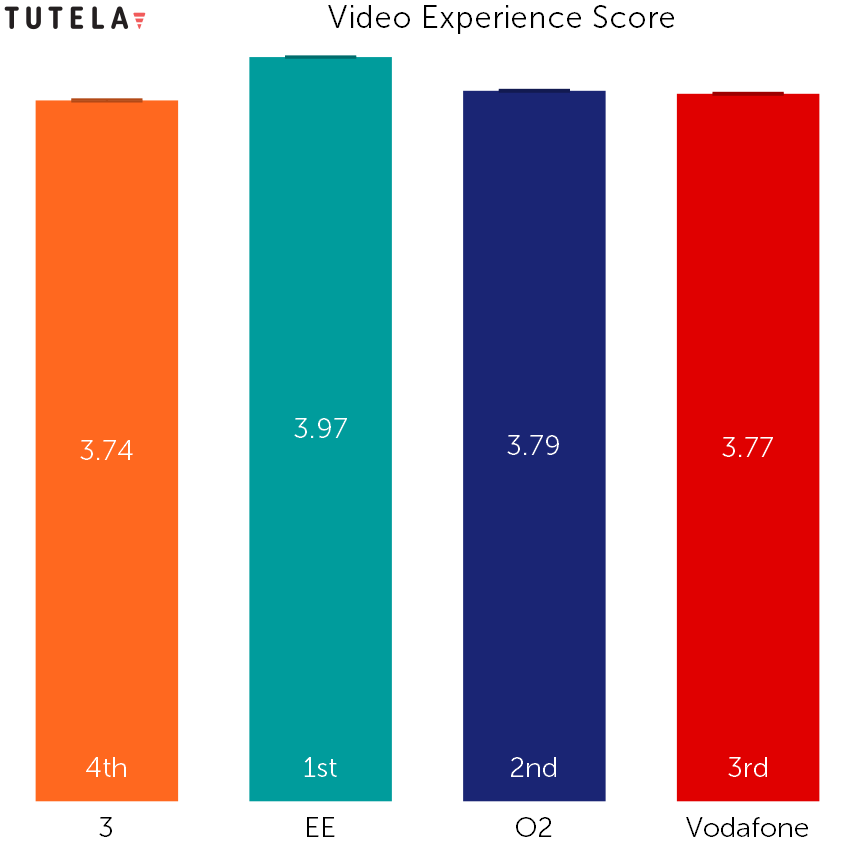
| 3 | EE | O2 | Vodafone | |
| Download median | 15.6 Mbps +/- 0.05 Mbps | 31.1 Mbps +/- 0.06 Mbps | 13.4 Mbps +/- 0.05 Mbps | 11.5 Mbps +/- 0.02 Mbps |
| Download % above 5 Mbps | 81.4% | 93.7% | 79.3% | 81.9% |
| Upload median | 9.6 Mbps +/- 0.03 Mbps | 10.0 Mbps +/- 0.02 Mbps | 9.2 Mbps +/- 0.02 Mbps | 9.1 Mbps +/- 0.02 Mbps |
| Upload % above 1.5 Mbps | 93.8% | 92.5% | 94.9% | 94.1% |
| Latency % below 50 ms | 99.4% | 99.8% | 99.9% | 99.7% |
| Jitter % below 12 ms | 96.6% | 98.3% | 97.6% | 98.0% |
| Packet discard % below 1% | 96.3% | 87.8% | 95.1% | 91.8% |
| 3 | EE | O2 | Vodafone | |
| Download median | 49.1 Mbps +/- 0.63 Mbps | 48.6 Mbps +/- 0.47 Mbps | 53.1 Mbps +/- 0.66 Mbps | 21.6 Mbps +/- 0.67 Mbps |
| Download % above 5 Mbps | 98.0% | 99.1% | 99.3% | 93.1% |
| Upload median | 17.0 Mbps +/- 0.49 Mbps | 12.7 Mbps +/- 0.27 Mbps | 15.8 Mbps +/- 0.46 Mbps | 13.0 Mbps +/- 0.32 Mbps |
| Upload % above 1.5 Mbps | 99.2% | 97.5% | 98.9% | 97.8% |
| Latency % below 50 ms | 99.8% | 99.9% | 99.8% | 99.7% |
| Jitter % below 12 ms | 98.2% | 98.5% | 97.2% | 98.1% |
| Packet discard % below 1% | 93.4% | 80.7% | 87.5% | 87.6% |
At Tutela we take data privacy seriously and do not collect any sensitive personal information. Please read our Privacy Charter (PDF) to learn more. Opt out (Do Not Sell My Info)
+1 (855) 6-TUTELA